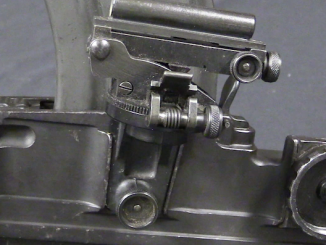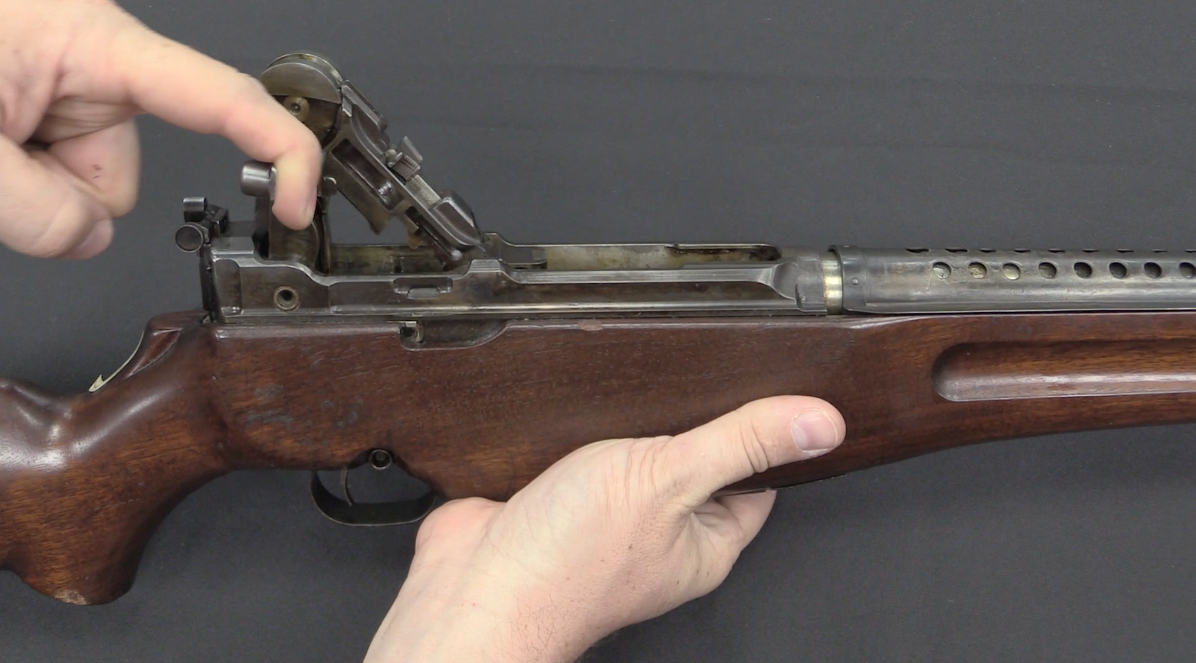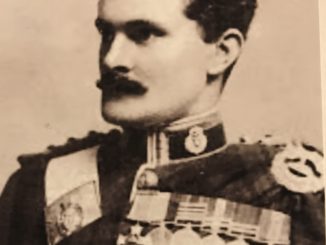We looked at the 7.62mm conversion of the No4 Enfield into Rifle L8 yesterday. Part of that program was an attempt to develop a new sniper rifle on the L8 platform. To this end, six good-quality No4(T) Lee Enfield sniper rifles were tested for accuracy, then made into L8 rifles and fitted with No.32 telescopic sights (the standard scope from the 303 days) and tested for accuracy again. Much to the chagrin of the Army, the new L8(T) rifles were barely able to match the performance of the .303 rifles they began as. The goal was to significantly improve on the No4(T) accuracy, and that was clearly not happening.
However, at this same time, British civilian competition shooters were having excellent success making 7.62mm versions of the No4. It was only when Enfield was willing to collaborate with the British NRA and others that they were able to successfully create the L42A1 rifle, which was at last met the accuracy goals of the program.
The rifle we are looking at today is one of those original six trials L8(T) rifles. Many thanks to the generous collector who allowed me to film it for you!




In the early ’60s, the Canadian DCRA had a program whereby members could have No. 4 rifles rebarreled by Canadian Arsenals Limited with 7.62×51 barrels. These generally did not shoot as well as .303 rifles. Various experiments were conducted with bedding, etc. in attempts to improve performance. These conversions are well marked and muzzles did not have bayonet lugs. Rules for competition soon changed and it was no longer necessary for rifles to have service configuration. Just as in the UK, rifles were substantially altered and often rebarreled with Enfield and Schultz & Larsen heavy barrels. Performance improved dramatically. There were also experiments done with the rifles’ bore and chamber dimensions in order to enhance performance with NATO ball.
Long Branch also made 7.62 No. 4 barrels with bayonet lugs. I believe these were barrels for the British L8 programme.
7.62 Nato ball 150 grain at 2750 feet per second versus .303 ball ammo 174 grain bullet at 2450 fps. lets not do anything to the stock and expect better accuracy! There is a recipe for lack of success. If you were to develop a load for 7.62 closer to .303 harmonics and the telescopic sight is actually of good quality and repeatable consistency it could be made to work. However if the scope cannot hold point of impact zero, but shifts even part of a millimeter in the mount or inside the tube there is no hope for good repeatable accuracy. And scopes were still in development for quality and durability at that stage, especially for the rough treatment given to any military rifle.
The Number 32 scope was actually pretty good, having been designed for use on the Bren gun.
Both sealing against moisture and shock resistance were excellent.
The age related criticisms that are true are related to the small objective, the low (4x) fixed power and the relatively coarse click stops on the adjustment turrets
The scope mounts were also pretty good,
The detachable section has a bar between the rings to relieve the scope of any structural loads from the mount.
The pads fastened to the receiver are screwed, with the screw heads staked to stop them loosening, and the pads are also soft soldered to the receiver.
It’s actually a more secure and rigid system than the vast majority of present day commercially made rifles have.
It is also detachable and replaceable without loss of zero.
The actual bore through the mount, to take the scope was individually line bored in place on the receiver to ensure that it is truly in line with the bore of the barrel – a far cry from most commercial rings.
Scope and scope mounts were not to blame for the poor accuracy
Both the scope an mounts continued in the successful L42A1 up to its final retirement.
“…lets not do anything to the stock…”(С)
And there you don’t need to do anything.
The stock of this rifle is just a piece of wood. And just make sure it sits firmly in its nest and is correctly aligned with the barrel. Tuning completed.
This butt is one of the main reasons “why this is the best service rifle.”
Regarding the front timber, I don’t think everyone had forgotten how to assemble these rifles by then.
In the manual for regimental gunsmiths everything is described.
In a properly assembled rifle, there is always a radial clearance between the barrel and the wood.
In fact, this is the FFB.
I think the problem is in the cartridge.
If they had guessed to use a slightly modified form of the chamber FG42.
They would solve both problems at once. Both increased bolt load and poorer alignment of the bullet axis with the barrel axis.
I actually had a No4 (Canadian manufacture 1945), bought brand new in packing. I never put a .303 round down it, it given to the battalion armourers, to convert to 7.62mm using a BSA conversion kit. Having also a cheekpiece placed on the left side of the butt, which worked extremely well. Never had any problems with, did have to shoot at Bisley with a L1A1 SLR, which the armourers also twicked. L8 was also issued to the Mauritius POlice General Service unit, which I saw and used in 1968. It also used by the Falklands Islands Defence Force up to 1982, and such as the Northern Rhodesian/Zambian and the Nyasaland/Malawi , and British Solomon’s Islands Police Forces. As well as other minor police bodies, including a number of UK police forces. I never had any problems the 7.62mm, it fired as well as my No 4 .303. The chap to whom I sold it in 1972, still has it, shooting full bore range, and for long distance feral pig killing.
Caliber conversions are never as simple as they look from the outset, sometimes even in weapons deliberately designed to accommodate such things.
Acquaintance of mine had one of those HK-4 multi-caliber pistol kits. His example only seemed to work well in .32 ACP, and only with specific European loads. Everything else was somewhat problematic, which was really odd because both he and I had seen and shot other examples of that pistol that exhibited none of those problems.
I speculate that maybe it was because when he got the kit, the only barrel that was really broken-in was the .32 ACP one, which had had maybe a thousand rounds through it. The others were essentially unfired, and the jams and other issues he had with it in those calibers dissuaded him from really firing those very much. Being as it was mostly a range toy, he just liked having it as an HK collector.
I’ll note, too, the issues that Glock had in trying to turn their pistol into a multi-caliber affair. What worked really well in 9mm Parabellum required extensive tinkering to get to work well in other cartridges, and you could argue that the conversion to .40 S&W never quite worked as well as the 9mm variants. It’s never quite as easy as it looks on paper…
The L8(T) has to be seen in the context of the abortive L8 program overall. It seems to have been mostly a commercial venture by Royal Ordnance which failed to take off as unsurprisingly most of the countries still using the No.1 or No.4 rifles for reasons of economy were quite happy to keep doing so as long as .303 ammo was available, and those that wanted to upgrade naturally wanted to upgrade to a newer, usually self-loading weapon as well. Once the superb hammer-forged 7.62mm barrels were produced by Enfield which were intended to be free-floated past the reinforce, the standard No.4 profile barrels were completely obsolete. The DCRA rifles are highly accurate, but not as good as the Enfield hammer-forged which can be MOA barrels out to 1000m and beyond.